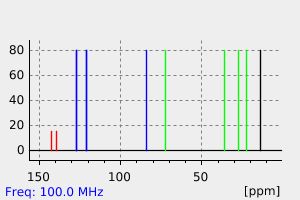异苯并呋喃,1-丁基-1,3-二氢- | 180068-03-5
中文名称
异苯并呋喃,1-丁基-1,3-二氢-
中文别名
——
英文名称
n-butyl phthalan
英文别名
Isobenzofuran, 1-butyl-1,3-dihydro-;1-butyl-1,3-dihydro-2-benzofuran
CAS
180068-03-5
化学式
C12H16O
mdl
——
分子量
176.258
InChiKey
LDWAVJQJYZWURQ-UHFFFAOYSA-N
BEILSTEIN
——
EINECS
——
-
物化性质
-
计算性质
-
ADMET
-
安全信息
-
SDS
-
制备方法与用途
-
上下游信息
-
文献信息
-
表征谱图
-
同类化合物
-
相关功能分类
-
相关结构分类
计算性质
-
辛醇/水分配系数(LogP):3
-
重原子数:13
-
可旋转键数:3
-
环数:2.0
-
sp3杂化的碳原子比例:0.5
-
拓扑面积:9.2
-
氢给体数:0
-
氢受体数:1
SDS
上下游信息
-
下游产品
中文名称 英文名称 CAS号 化学式 分子量 3-丁基-1(3H)-异苯并呋喃酮 butylphthalide 6066-49-5 C12H14O2 190.242 1-(2-甲基苯基)-1-戊醇 1-(2-methylphenyl)-1-pentanol 73178-44-6 C12H18O 178.274 (2-戊基苯基)甲醇 o-amylbenzyl alcohol 110683-66-4 C12H18O 178.274
反应信息
-
作为反应物:描述:参考文献:名称:α-当归内酯催化异色团和酞菁的苄基sp3 CH键的氧化。摘要:已开发出一种无金属的有机催化系统,用于使用氧气作为氧化剂对环醚进行高效苄基CH氧化。该氧化反应利用α-当归内酯作为低成本/低分子量催化剂。优化的反应条件允许从容易获得的前体以高收率合成有价值的异香豆素和邻苯二甲酸酯。机理研究表明,该反应途径可能涉及通过过氧化物中间体的自由基过程。DOI:10.1039/d0ob00729c
-
作为产物:描述:参考文献:名称:An Efficient and Stereoselective Conversion of Lactones to Substituted Cyclic Ethers摘要:A general route to substituted cyclic ethers has been described by using nucleophilic addition of Grignard reagents to lactones in the presence of CeCl3 followed by the Lewis acid-induced deoxygenation of the corresponding hemiketals with Et3SiH. Stereoselective reduction of the 5-membered adducts to the disubstituted tetrahydrofurans has been also investigated.DOI:10.3987/com-97-8060
文献信息
-
Enzyme-Inspired Coordination Polymers for Selective Oxidization of C(sp<sup>3</sup>)–H Bonds <i>via</i> Multiphoton Excitation作者:Huilin Huang、Xu Jing、Jiangtao Deng、Changgong Meng、Chunying DuanDOI:10.1021/jacs.2c09348日期:2023.2.1transfer (LMCT) process from the consecutive excitation of the in situ formed copper(II) center. The chlorine radical abstracts a hydrogen atom selectively from C(sp3)–H bonds to generate the radical intermediate; meanwhile, the O2•– species interacted with the mimic to form mixed-valence species, giving the desired oxidization products with inherent product selectivity of copper monooxygenases and recovering大自然的蓝图为扩大丰富金属在催化领域的应用提供了基本原则;然而,在一个用于选择性 C-H 键氧化的人工系统中同时模拟铜酶的结构和功能面临着巨大的挑战。在此,我们报告了一种组装人工单加氧酶的新方法,该方法利用双核 Cu 2 S 2 Cl 2簇来复制 Cu A酶的相同结构和催化作用。设计的单加氧酶 Cu-Cl-bpyc 促进明确定义的氧化还原电位,该电位最初通过光诱导电子转移激活 O 2 ,并通过来自原位形成的铜(II)中心的连续激发的配体到金属电荷转移(LMCT)过程。氯自由基选择性地从 C(sp 3 )–H 键中夺取一个氢原子,生成自由基中间体;同时,O 2 •–物种与模拟物相互作用形成混合价物种,提供具有铜单加氧酶固有产物选择性的所需氧化产物,并直接回收催化剂。该酶促方案具有出色的可回收性、良好的官能团耐受性和广泛的底物范围,包括一些生物学和药理学相关的靶标。机理研究表明,C-H 键断裂
-
Ultrathin 2D Cerium‐Based Metal–Organic Framework Nanosheet That Boosts Selective Oxidation of Inert C(sp3)H Bond through Multiphoton Excitation作者:Guanfeng Ji、Liang Zhao、Yang Tang、Songtao Liu、Yefei Wang、Cheng He、Chunying DuanDOI:10.1002/smll.202300597日期:2023.6Benefiting from framework confinement effects, synergistic effects of two active sites and/or flexibility of the ultrathin framework nanosheets with high surface utilization, the observed activities increase in the order CeCl3/MV+ < bulk 3D MOF crystals < 2D MOF nanosheets in photocatalysis. This work not only contributes a new strategy to construct 3D layered MOFs and their ultrathin nanosheets but also开发诱导和定制催化剂活性的方法是各种催化中的一个重要问题。通过剥离3D层状MOF获得的超薄2D单层金属有机框架(MOF)纳米片具有更容易的活性位点和更快的扩散速度,作为多相催化剂具有巨大的潜力,但3D层状MOF的合理设计和制备仍然是一个巨大的挑战。在此,采用了一种新颖的弱静电相互作用策略,通过协调氯封端的铈节点和线性光活性甲基紫精(MV + )有机连接体来构建3D层状含铈MOF。在多光子激发下,MV +配体和 Ce Cl发色团被连续触发形成高活性氯自由基(Cl • ) ,通过氢原子转移激活惰性C(sp 3 ) H键。受益于框架限制效应、两个活性位点的协同效应和/或具有高表面利用率的超薄框架纳米片的灵活性,在光催化中观察到的活性按CeCl 3 / MV + <块状3D MOF晶体<2D MOF纳米片的顺序增加 。这项工作不仅为构建 3D 层状 MOF 及其超薄纳米片提供了一种新策略,而且为使用纳米结构
-
Electron-Transfer-Induced Reductive Cleavage of Phthalans: Reactivity and Synthetic Applications作者:Ugo Azzena、Salvatore Demartis、Giovanni MelloniDOI:10.1021/jo9604548日期:1996.1.1The behavior of phthalan (1a) was investigated under conditions of electron transfer from alkali metals in aprotic solvents. Reaction with lithium in the presence of a catalytic amount of naphthalene in THF led to the reductive cleavage of an arylmethyl carbon-oxygen bond, with formation of a stable dilithium compound. Trapping of this intermediate with several electrophiles (alkyl halides, carbonyl derivatives, CO2) was successful. The extension of this procedure to several substituted phthalans (1b-i) was investigated, and the regiochemistry as well as the synthetic usefulness of these reactions are discussed.
表征谱图
-
氢谱1HNMR
-
质谱MS
-
碳谱13CNMR
-
红外IR
-
拉曼Raman
-
峰位数据
-
峰位匹配
-
表征信息
同类化合物
麦考酚酸羧丁氧基醚
麦考酚酸-d3
霉酚酸钠
霉酚酸酯杂质3
霉酚酸酯杂质1
霉酚酸酯EP杂质H(霉酚酸酯-USP相关化合物B)
霉酚酸甲酯
霉酚酸环丙烷类似物
霉酚酸吗啉乙酯
霉酚酸内酯
霉酚酸-(全碳-13)
霉酚酸
阿夫洛尔
袂康宁-d3
苯酞
艾司西酞普兰杂质
艾司西酞普兰杂质
盐酸氮淖斯汀杂质SM3-I5
盐酸氮卓斯汀杂质E
正丁亚基邻苯二甲酰胺
托格列净一水合物(1:1)
托格列净
异苯并呋喃,1-丁基-1,3-二氢-
异苯并呋喃,1-[(3-氯苯基)亚甲基]-1,3-二氢-,(Z)-
川芎内酯E
川芎内酯 C
四氯苯酞
呋吡菌胺
亚苄基酞
丁苯酞标准品028
{3-[5-溴-1-苯基-3,3-二甲基-1,3-二氢-异苯并呋喃-1-基]-丙基}-二甲基-胺
m-袂康宁
Z-亚丁基苯酞
O-甲基吗替麦考酚酯
N-苯基邻苯二甲酰亚胺高氯酸盐
N-环己基邻苯二甲酰亚胺高氯酸盐
N-(3-氧代-1H-2-苯并呋喃-5-基)乙酰胺
N,N-二甲基-4-(3-甲基-1,3-噁唑烷-2-基)苯胺
7-羟基-6-甲氧基苯酞
7-羟基-5-甲氧基-4-甲基苯酞
7-羟基-5-甲氧基-3H-2-苯并呋喃-1-酮
7-羟基-3H-2-苯并呋喃-1-酮
7-硝基-1(3h)-异苯并呋喃酮
7-甲氧基苯酞
7-甲氧基-8-氧杂三环[4.3.0.07,9]壬-1,3,5-三烯
7-甲氧基-6-甲基-1-氧代-1,3-二氢-异苯并呋喃-4-甲醛
7-甲氧基-4-甲基苯酞
7-甲基苯酞
7-溴-4-甲氧基苯酞
7-溴-3H-2-苯并呋喃-1-酮







